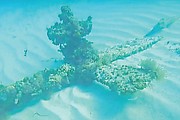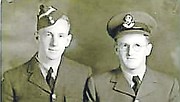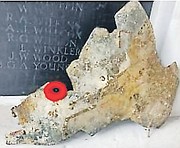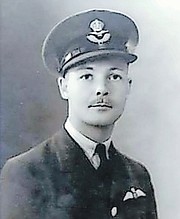On October 17, 1944, five years into World War II, a B-26 Marauder aircraft assigned to the Royal Air Force Transport Command took off from the Windsor Field.
Two young Canadians were training at takeoffs and landings and were on their seventh such touch-and-go when their starboard engine caught fire.
The pilots, Jack Wood of Toronto and Maurice O’Neill of Halifax, struggled to cross Prospect Ridge for three minutes from 10.21 am; after crossing this ridge at what is now Super Value, at likely over 100mph, with the starboard engine useless, smoking, possibly the four large propeller blades unfeathered.
The B-26 was known as a “Flying Prostitute” because of its small wing area (no visible means of support) and was a handful on one engine.
Among those who hated the airplane were the crews of the Air Transport Command’s Ferrying Division who picked the Marauders up at the factory and delivered them to combat units.
Those who loved it included Lt Gen James H “Jimmy” Doolittle, who used a B-26 Marauder as his personal airplane, and most of the pilots and crew members who flew the airplane in combat.
In the winter of 2021, I felt it a duty to find this wreck. And the niece of pilot Jack Woods told me to be safe and smart, not to end up dead as well.
My godson was working in a scuba company and I had planned to give him this location to dive, but he passed in June 2021, and I was determined to find it for his memory.
In November 2021, as our mother fought for the last weeks of her life, I did.
The moment that I knew I’d found the aircraft with two men entombed was laying eyes on the distinctive military four-bladed engine on the seafloor, with cowlings, radio, seats, and unopened bottle. I logged the day thus: “Swim Day 6: heavy round steel or iron objects, with an aluminum find or skeg of some type, pieces of aluminum, chair seat (actually escape hatch) found but left, as was the engine with four propellers - found twice never logged, never photographed).”
They crashed in shallow waters just 400 yards or so off the coast where a nurse and doctor ran to watch.
On a calm day they would likely have survived, but a building hurricane made for large chop which caused the plane to disintegrate.
A pilot said “loss of an engine on take-off is the most critical thing in flying, and if you can’t get the prop on the failed engine feathered quickly the drag will stall you, and in you go”.
A nurse living on Cable Beach said she thought she saw men scrambling along one of the wings but could not be sure.
The seat and hatch were later recovered, and a surveillance camera switched.
Fishermen from nearby Delaport village were seen over the wreck, but nothing was recovered for nearly 80 years.
Three weeks later, navy divers went to the crash site and “no traces of bodies - aircraft completely wrecked and now disintegrated”.
RAF Transport Wing No 113, which is an RAF Transport Wing based in Nassau and Montreal, war dairy relates: “Crashed into sea 500 yards off north shore ...Aircraft entirely submerged; no survivors recovered from aircraft.”
It wrecked off the Marley Resort, Delaport Bay, in just 12ft of water.
Jack Wood RCAF, was 28 years old, 5’9” and of medium build, with grey eyes and brown hair and a mustache. His wife was Grace Edwina Ruth and parents Walter and Elsie, both born in Putney and Yorkshire, in the UK. Jack’s niece shared that he was an assistant dress buyer for Robert Simpson Eastern. From 1932-33, he was a cadet in Hamilton. He played rugby, swam, did track and field.
Co-pilot Maurice Francis O’Neill was 27 years old and unmarried. His parents were Francis Maurice and Rose O’Neill. He attended St Mary’s University, Halifax, and his kid brother Neville J, was also in the service. Maurice was a retail clerk whose father was from Ketch Harbor, Nova Scotia and owned a stationary business.
Maurice joined the 1st Artillery Battery as a gunner. They enlisted and trained in very close proximity to one another and are remembered in the Ottawa Memorial, though neither appears in the Bahamian cathedral or cemetery lists, they are in the War Cemetery among the names, and a piece of the plane and poppy were lain at their memorial on the anniversary of when they died suddenly together.
Inventoried after his death, Maurice O’Neill’s personal effects included: “blue side bag, key, hat, religious pendant, small note book, lot of papers, socks, handkerchiefs, swimming trunks, playing cards, padlocks, pencil refills, prayer beads, filigree silver cigarette case, 6 foreign coins in an envelope, diary, perfume, bracelet, money belt, leopard skin ladies’ handbag, leather bag fancy, book, radio replies, foreign notes, prayer book, brushes, broken torch, razor, scissors.... mirror,”
Just over a month after the fatal crash the Reverend Flint joined Wing Commander Blaskett, DFC, Commanding Officer, and six other RAF VIPs aboard an air search and rescue vessel to perform a solemn wreath-laying with photographs and flowers on the sea above the site.
After the war, the B-26 bomber used to bomb Tokyo in the Doolittle raid and incapacitate Axis Europe’s munitions strength were themselves destroyed and dismantled to rebuild Germany; 2,000 were scrapped.
Equipped with only snorkel gear and an inflatable raft, by swimming three times a day for up to five hours alone, I was able to identify the mangled aircraft from pieces of metal protruding from beneath the sand. The police and RBDF were called to find and rescue me twice.
Jack Wood had many items to list, from socks to batteries, short, kid gloves, shoulder straps, films, pocket knife, shoe trees, had, fountain pens, torch, hair push, letters and papers, overshoes, white towel, chamois vest, blue tunic, gaberdine windbreaker, pipe, pilot’s brevet, propelling pencils, cribbage board, leather writing folder, leather cigarette case, book “Life with Father,” packet of golf tees, book of four photographs, ...swimming trunks...”
I think of his poor dad, Walter, and as a father how moved he must have been to learn his son’s last reading was a book named Life with Father.
Jack’s niece, Joanne Green, said her mother was crushed to have lost her brother, and that she too wishes she knew her charismatic and charming dress-buying uncle Jack.









Comments
Thunderbird 12 months ago
Eric's research efforts are outstanding. There is however, one inaccuracy in the Tribune account.It was the B25 Mitchell that took part in the Dolittle raid and not the B26 Marauder.
Sign in to comment
Or login with:
OpenID